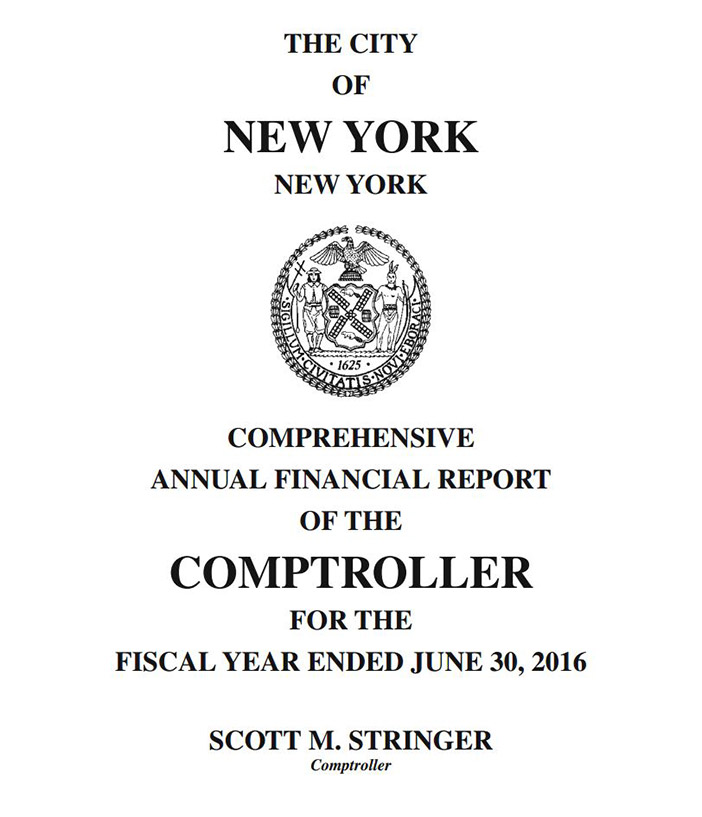Courtesy of City Comptroller’s Office
By Forum Staff
City Comptroller Scott Stringer on Monday released the Comprehensive Annual Financial Report for Fiscal Year 2016, which includes the City’s audited financial statements for the year, outlines important economic and financial data about the five boroughs, and highlights work done by the Comptroller’s Office during the previous fiscal year, Stringer noted.
“At every turn, accountability and transparency in government makes our Citystronger and this year’s CAFR once again meets the highest standards for fiscal reporting,” Stringer said. “I thank my colleagues from the five pension systems, the Mayor’s Office of Management and Budget, the Office of the Actuary, and so many of my staff members – especially from our Bureau of Accountancy – for their work in producing this vital report.”
For the first time, this year’s CAFR includes new information about the City’s tax abatement programs to help members of the public understand specific abatements’ purposes, program qualifications and requirements, and how tax abatements affect the City’s bottom line. Although the Governmental Accounting Standards Board Statement #77 requires these disclosures by Fiscal Year 2017, the Comptroller’s Office chose to provide this transparency a year early.
In accordance with the City Charter, the CAFR is released annually no later than Oct. 31. In addition to the financial statements of the City as a whole and for each of the City’s accounting funds, explanatory notes to the financial statements, and supplemental financial and statistical information about the City, the CAFR contains the financial statements of the City’s five pension systems, closely-related entities such as New York City Health + Hospitals, the NYC Water and Sewer System, and the NYC Economic Development Corporation, Stringer said.
Highlights from the 434-page FY2016 CAFR include:
- For the 36th year in a row, New York City completed the fiscal year with a General Fund surplus. In FY16, the General Fund surplus was $5 million.
- The City’s Real Gross Product grew 3.1 percent, nearly double the national GDP growth of 1.7 percent in FY16.
- New York City added 98,100 private-sector jobs, driving down citywide unemployment to 5.3 percent, the lowest rate since FY08. In FY2016, the unemployment rate was 4.6 percent in Queens, 4.5 percent in Manhattan, 5.3 percent in Staten Island, 5.4 percent in Brooklyn, and 7.2 percent in the Bronx. More than half of the new jobs were in medium and high-wage sectors, Stringer pointed out, bucking a five-year long trend of job growth primarily in low-wage industries.
- As of June 30, 2016 the Comptroller’s Bureau of Asset Management had $165.2 billion of assets under management for the New York City Retirement Systems.
- The pension trust funds earned $2.9 billion in investment income, net of investment expenses, in Fiscal Year 2016. Employer and employee contributions totaled $10.8 billion and $1.9 billion respectively, and they made payments to beneficiaries totaling $14.1 billion.
- The City, the New York City Transitional Finance Authority, and the New York City Municipal Water Finance Authority issued a total of $9.76 billion of long-term bonds to finance the City’s capital program and refinance higher coupon bonds for interest savings. The refundings will generate $770.65 million in budgetary savings over the lifetime of the bonds.
- All General Obligation bonds issued by the City in FY16 were refunding bonds. As of June 30, 2016 the City’s outstanding GO debt totaled $38.07 billion, consisting of $31.13 billion of fixed rate bonds and $6.94 billion of variable rate bonds.
The FY15 CAFR was awarded the Certificate of Achievement for Excellence in Financial Reporting by the Government Finance Officers Association. This is the 36th year in a row the City has received this prestigious award, Stringer noted.

